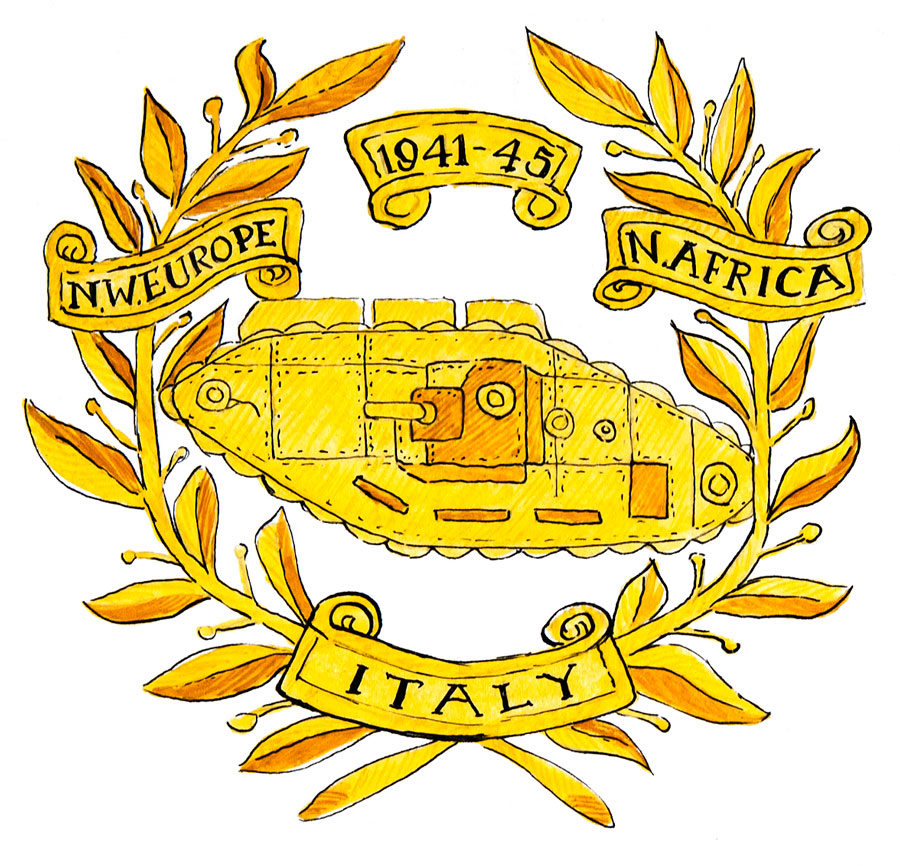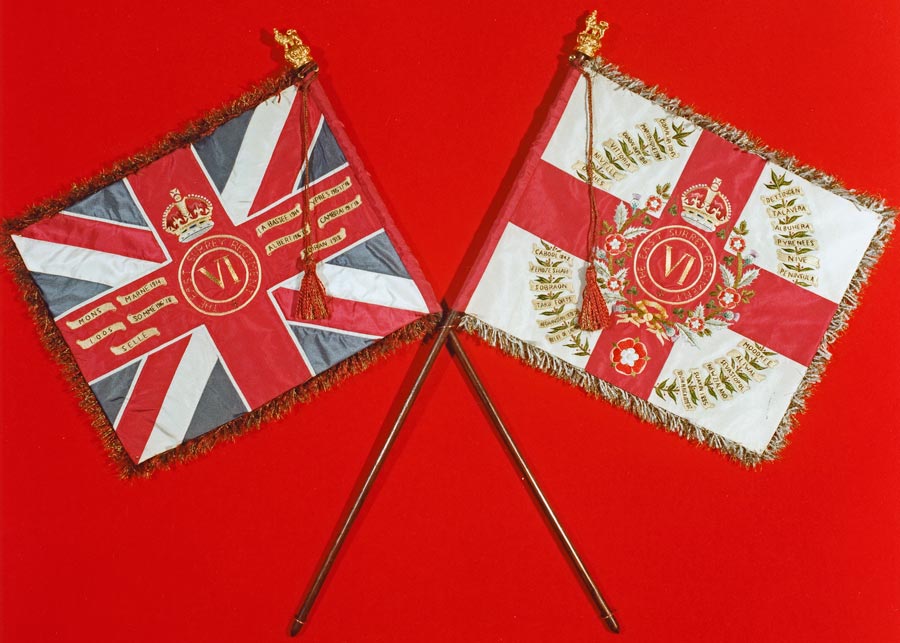The Colours of The East Surrey Regiment
(and its forebears the 31st and 70th of Foot)
Territorial Battalions
As originally raised, the Volunteers had no Colours. Colours were granted and presented after the establishment of the Territorial Force in 1908, which brought Territorial Battalions formally onto the Regimental Establishment.
The 5th Battalion received its Colours from King Edward VII on 19th June 1909 at Windsor Castle. These Colours conformed to the 1864 pattern of the 1st East Surreys, that is, King’s Colour: the Union, with in the centre a roundel bearing the Regimental title and battalion numeral in Roman surmounted by a King’s crown. Regimental Colour: the red cross of St George on a white ground with in the centre a roundel bearing the Regimental badge – a lion couchant guardant in front of a castle, the centre tower charged with the arms of Kingston-upon-Thames, all on an eight-pointed star. This was surrounded by a wreath of laurels with the united red and white rose at the bottom centre of the Colour. The battalion numeral, a Roman V, was placed in the first canton. The King’s Colour bore originally only the battle honour “South Africa 1900 - 1902”. The pre-1914 battle honours of the regular battalions, and the authorised ten Great War Honours on the King’s Colour, were added after the Great War. These Colours remained with the battalion after it left the Regimental order of battle and was converted to Royal Artillery in 1938, and were not laid up until 1967. The ten selected Second World War Honours were never added.
The 6th Battalion did not receive its Colours until 9th June 1928. These were presented by Colonel the Lord Ashcombe at the Barracks, Kingston, and conformed to the pattern of the 5th Battalion described above, except for the Roman numeral VI in the first canton of the Regimental Colour and the centre of the King’s Colour. Again, until 1925 the Regimental Colour bore only the Honour “South Africa 1900 - 1902”; the pre- 1914 Honours of the regulars and the ten selected Great War Honours were added in 1925; those of the Second World War were added in 1957. These Colours were laid up in All Saints’ Church, Kingston, after the battalion was amalgamated into 4th Queen’s Surreys, in 1963.
The 7th Battalion, later 23rd London Regiment, received its Colours from King Edward VII on 19th June 1909 at Windsor Castle. These Colours conformed to the pattern described under the 5th and 6th Battalions, but with a number of significant differences. The King’s Colour bore the title “The London Regiment (County of London)” on the central roundel, and in the centre the numeral XXIII. After the Great War, ten selected Battle Honours, different from those of the remainder of The East Surrey Regiment were added under the authority of Army Order 5 of 1925:
FESTUBERT 1915 |
LOOS |
|
SOMME 1916, ’18 |
MESSINES 1917 |
|
CAMBRAI 1917 |
YPRES 1918 |
|
MACEDONIA 1916-17 |
GAZA |
|
JERUSALEM |
JORDAN |
 |
| Figure 60 |
| Regimental Colour 23rd (County of London) Bn. The London Regiment, (1909-63). Showing the Bridge House Mark in the centre. |
 |
| Figure 61 |
| NORTH-WEST EUROPE NORTH AFRICA ITALY (Click to enlarge) |
The Regimental Colour bore, instead of The East Surreys Badge, an annulet ensigned with a cross pattée and interlaced with a saltire conjoined at the base (known as the Bridge House Mark). The numeral XXIII was placed in the first canton. The wreath was not of laurels, but the union wreath – that is roses, thistles, shamrocks and daffodils. The Battle Honours of the Regular East Surrey battalions were never authorised to be added to these Colours. In 1921 the motto “Loyalty Unites Us” was added on a scroll across the bottom of the wreath. Until 1957 the Regimental Colour bore only the Honour “South Africa 1900 - 1902” on a scroll below the motto. An Honorary Distinction was then added to the bottom centre of the Colour: the badge of the Royal Tank Regiment with the year dates 1941 – 1945 and three scrolls commemorating the service of the Regiment as 42nd RTR from 1938 until it rejoined the East Surrey order of battle in 1956:
These Colours were laid up in St Mary’s Church, Battersea, after the battalion was amalgamated into 4th Queen’s Surreys, in 1963.
Related

